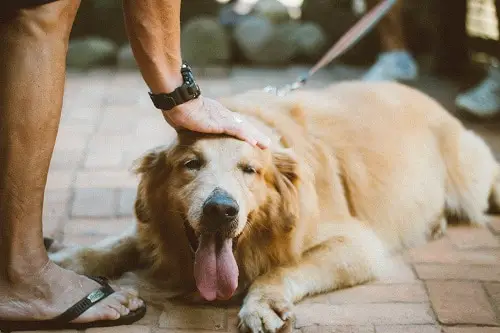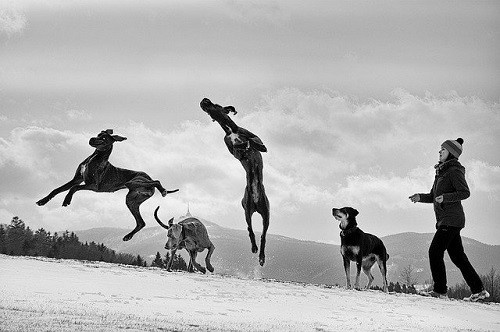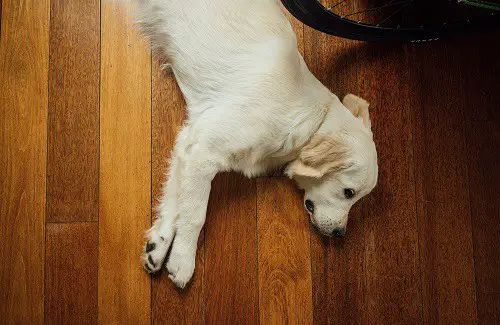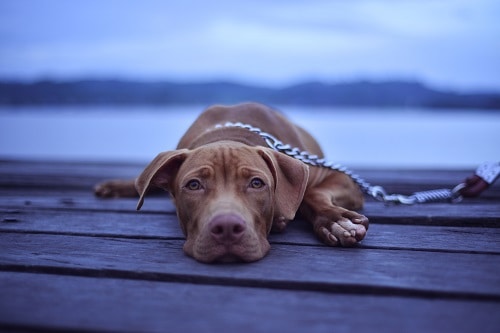Dogs love to exercise and have fun with their owner. Running with your dog, playing to fetch or frisbee and swimming in the pool or at the beach are all fun things to do with your companion. However, too intense or too much exercise could lead to problems such as acute collapse!

If your buddy has fallen over, it’s never a good sign. Moreover, many things could cause an acute collapse in dogs. Sometimes, it can happen after running or any other intense exercise. Why does your dog collapse after running or exercise? Is it dangerous for him? What can you do if he falls on the ground? … Here’s what I’ve found on collapse in dogs!
Acute collapse in dogs is a sudden loss of control and strength, that makes them fall over. There are a lot of possible explanations of why dogs can collapse, especially after running or exercising. It could be due to a genetic disorder Exercise-Induced Collapse (EIC), failure in the circulatory system or many other health conditions.
What Is Acute Collapse In Dogs?
It’s simply an unexpected loss of control on their body. An acute collapse will cause these animals to fall on the ground and don’t have enough strength to get up!
Be careful to not mix any health problem; collapsing isn’t the same thing as fainting. The difference is simply that when a dog collapses, he normally stays conscientious. Furthermore, the reasons why your dog collapsed or fainted are different!
To give you a human comparison, fainting in dogs is very similar to passing out or simply fainting. Collapse is also similar, but they normally stay awake during their loss of strength. You could see some signs before your dog falls on the ground such as confusion, weakness, disorientation, staggering, vomiting or diarrhea!
Your Dog Collapsed?
He could only fall into a sitting position that means it’s only a hind limb collapse. Your pooch could also do a complete collapse by falling on the ground into a lying position. For dogs that lose consciousness, they suffer from syncope (or fainting)!
This health problem could be more serious and caused by neurologic or cardiac issues. After dogs remain conscious, they could feel confusion, anxiety, and be disoriented!
Here Are Some Things That Could Cause Fainting!
Neurologic Problems:
- Seizures.
- Abnormal Brain Activity.
Cardiac Problems:
- Abnormal Heart Rhythms.
- A-V Block.
- Ventricular Tachycardia.
- Ventricular Fibrillation.
Don’t Confuse Fainting or Collapse With Seizures!
In general, seizures are caused by conditions like epilepsy. Most dogs that have that health problem are totally normal between their epileptic seizures. However, an acute collapse is normally a disorder of the nervous system, musculoskeletal system, circulation or respiratory system!

What You Should Do For Fainting or Acute Collapse?
Just bring them to the veterinarian or an emergency clinic the faster you can. Take this kind of symptom very seriously. Try to seek immediate attention when you’re at the vet or emergency clinic!
Even if you can’t do many things to help your dog directly, you can help to find the cause of the syncope. By taking your dog’s pulse or finding his heartbeat, try to analyze if it’s fast or slow. This could help your vet to find if the cause is cardiac or neurologic. You could also videotape your dog to help the professionals to determine the origin with what he looks like!
What Could Be Wrong?
There are a lot of possible issues that can cause acute collapse in dogs. Professionals will be more efficient to find the health condition of your dog. If your buddy collapses for more than a few minutes or loses his consciousness, bring him imperatively to your vet or an emergency clinic!
Here Are Some Things That Could Cause Acute Collapse In Dogs!

- Dehydration.
- Shock or Severe Hypotension.
- Internal Bleeding or Severe Anemia.
- Heat Stroke.
- Neurologic Problems.
- Neuromuscular Issues.
- Musculoskeletal Problems.
- Cardiac Issues.
- Endocrine Diseases
- Poisonings.
- Pregnancy.
- Severe Reactions. (Insect Bites, Stings or Drugs)
- Respiratory, Heart or Blood Diseases.
- Diabetes.
- Etc.
With all these possibilities, it can be very difficult to find the cause. However, if it arrives directly after an intense effort, it could be related to that. Collapse for no reason or collapse after running isn’t the same thing. Mentioning this information could help your vet to find the origin of this problem!
Why Does Your Dog Collapse After Running?
There’s a lot of health problems that can cause acute collapse after too intense or too much exercise. Running can be very fun, but you always need to respect your dog’s physical capacities. That’s also why it’s always important to look at your companion while jogging to prevent collapse, fainting, heatstroke, etc.
Be Aware of Your Dog’s Exercise Needs!
As you know, your furry friend will need plenty of physical activity. Depending on his breed, energy, size, and other elements, his exercise requirement will vary a lot. In general, most dogs will need around 30 to 60 minutes of physical activity every day. Nonetheless, this daily exercise need could be anywhere from 20 minutes (e.g. Newfoundlands) to 2 hours (e.g. Australian Cattle Dogs or Labs)!

Many furry friends don’t have enough playtime. It can have many bad repercussions on their health and general well-being. However, it’s also easy to over-exercise your dog. That’s why you need to respect your dog’s limits and conditions!
Here Are The Main Things That Can Cause Collapse After Running!
- Exercise-Induced Collapse (EIC).
- Over-Exercise.
- Dehydration.
- Heat Stroke.
- Cardiac Issues.
- Etc.
What Is The Exercise-Induced Collapse (EIC)?
This is simply a genetic disorder that causes collapse after intense exercise. Dogs with this health condition can’t do too vigorous exercise without having weakness and collapse after. Even with only 5 to 20 minutes can lead affected dogs to fall on the ground. If your dog has this condition, you always need to stop exercising to any sign of disorientation or wobbliness!
Here Are Some of The Dog Breeds Prone To EIC!

- Sporting Dogs Group. (Especially Retrievers and Spaniels.)
- Labrador Retrievers.
- Chesapeake Bay Retrievers.
- Curly Coated Retrievers.
- Boykin Spaniels.
- Cocker Spaniels.
- Old English Sheepdogs.
- Pembroke Welsh Corgis.
- Etc.
If the collapse related to the intense physical effort, it would restrict the number of possible issues. However, it’s not because it happens after running or any other canine sport that it’s linked to vigorous exercise!
How to Take Care of Your Dog After Collapsing?
I already explained to you how to react after fainting. Collapse is a little bit less serious than syncope, but it still needs imperative action. You should always go seeing your vet when something like that happens!
If the collapse lasts for more than a few minutes or becomes fainting (unconscious dog), bring him directly to an emergency clinic or your veterinarian. Be very careful about transporting your injured dog. He could be very confused, disoriented or even aggressive. After that, let the professionals do their job!

How To Prevent The Risks of Collapse In Dogs?
Unfortunately, you can rarely prevent this kind of problem. Nevertheless, I’ve found some precautions to minimize the risk of collapse!
Visiting your vet regularly is good for many reasons. That’s the best way to prevent any kind of health problems when it’s possible. For example, your vet could discover a heart or respiratory before it’s become more serious and dangerous!
Giving some rest to your dog is crucial to avoid health issues. Running with your dog too long distances or being too active on sunny days could be dangerous for him. Make sure to respect his limits and conditions!
Last Thoughts About Running And Collapse!
Running could be very interesting to keep you and your companion both in shape and happy. Some active dogs need to have more intense exercise time. However, always ask your vet before changing something in your dog’s workout routine!

Collapse, faint or seizure are things to take care of very seriously. Always ask for professionals before trying anything. Bring your dog to the vet or an emergency clinic and everything should be alright!
Important Disclaimer: I’m not a professional and every dog has unique conditions. Your veterinarian is always the best person to take care of your buddy’s health. I just want to help dog owners become more active with their companion safely. Make sure to know your pooch well and respect his conditions to enjoy canine activities without any problem!
Have Fun!